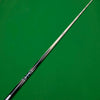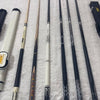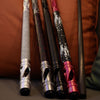The Ultimate Guide to Buying a Pool Cue: Understand Core Parameters from Material, Weight to Joints

For billiards enthusiasts, a well-fitted cue is key to improving performance. Newcomers often feel confused when faced with parameters such as maple vs. ash, weight differences, and joint types. This article breaks down core parameters to help you find the right cue.
I. Material: The Basic Character of the Cue
Ash: The traditional choice for snooker cues, with clear straight grains. The wider the grain spacing, the better the elasticity. It delivers delicate feedback, ideal for precise control shots like draw and stop shots, suitable for Chinese eight-ball and snooker. However, it's sensitive to humidity and requires regular maintenance.
Maple: Known for its uniform texture and hardness, with a lighter color. It has stronger hardness and direct force transmission, performing stably in powerful shots and breaking, suitable for American nine-ball and ten-ball. It's more stable than ash and easier to maintain.
II. Shaft: The Key to Ball Control
Maple Shaft: Available in hard maple and soft maple. Hard maple is good for precise positioning with clear feedback; soft maple has better elasticity, suitable for spin shots with less cue ball deflection. High-quality maple shafts undergo years of natural drying. When purchasing, check if the shaft is straight and the grain is uniform.
Carbon Fiber Shaft: Features zero deformation and high consistency, unaffected by temperature and humidity, suitable for frequent travelers. It has high hardness and efficient force transmission, with strong breaking power but a duller feedback.
Shaft taper: Gradual taper is for delicate control; steep taper is for powerful shots.
III. Weight: Adjusting Balance
Mainstream weights range from 18-21 ounces, with differences affecting feel:
- Light weight (18-19 oz): Suitable for beginners and those focusing on control, offering smooth swings and less fatigue, good for spin and positioning, ideal for snooker and Chinese eight-ball.
- Medium weight (19.5-20.5 oz): Balances control and power, suitable for most Chinese eight-ball and American eight-ball players.
- Heavy weight (21+ oz): For those pursuing power, advantageous in breaking and long shots, but may add burden, 慎用 for beginners.
Beginners are advised to start with 19-19.5 ounces.
IV. Balance Point: The Fulcrum of Swing
Measured by the distance from the balance point to the butt end, mainstream range is 40-45 cm:
- Forward balance (40-42 cm): Heavier front part, suitable for draw shots to enhance backspin, but less flexible.
- Rear balance (43-45 cm): Heavier rear part, with a stronger swinging feel, suitable for American nine-ball and ten-ball, flexible for spin but with weaker draw effect.
Judgment method: Hold the cue at the balance point with one hand; it's suitable if it can balance naturally.
V. Joints: The Stable Link
3/8-10 Joint: Mainstream in snooker, with 10 threads, offering tight connection, high concentricity, and good force transmission. But it's slow to disassemble, and threads wear easily, requiring regular maintenance.
5/16-18 Joint: Common in American cues, with 18 fine threads, providing stable connection and easier disassembly than 3/8-10, suitable for American eight-ball and nine-ball.
Uni-Loc Joint: A quick-release design, assemble in seconds, suitable for frequent carrying, with excellent concentricity and force transmission close to one-piece cues. But it's more expensive, and the spring structure may wear over time.
Radial Joint: Has excellent concentricity and lossless force transmission, suitable for professional players. But disassembly requires special tools and is more cumbersome.
VI. Tip: The Contact Point with the Cue Ball
Size: 9-13 mm, 9-10 mm for snooker, 11-13 mm for Chinese eight-ball and American pool. Larger tips have higher spin tolerance; smaller ones require more precision with finer spin.
Hardness: Soft (S) is good for spin and delicate control but wears quickly; Hard (H) is durable with direct force transmission, suitable for breaking and long shots; Medium (M) is a balanced choice for beginners.
Beginners are advised to choose an 11 mm, medium hardness (M) tip.
VII. Ultimate Buying Advice
- Clarify needs: Distinguish between casual play and advancement, and determine the main game type.
- Set a budget: Entry-level (100$-300$ ), mid-level (300$-700 $), professional-level (over 700 $).
- Test in person: Feel the feedback of cues with different parameters and choose the one with smooth force and easy control.
A cue is both a tool and a partner. Parameters can be quantified, but the fit of feel takes time to adapt. Just choose a cue you're willing to pick up often.





